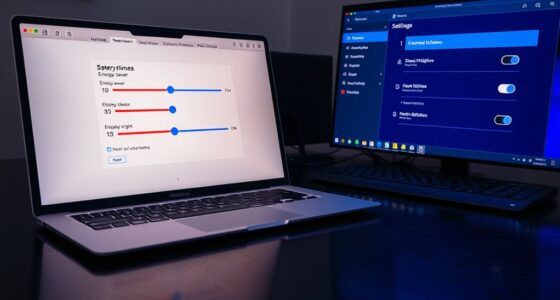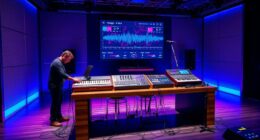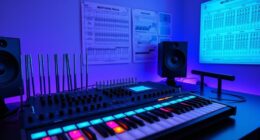To oversample without overloading your CPU, selectively enable oversampling only on critical plugins or sections that need it most, rather than globally applying it. Use internal oversampling features optimized for efficiency, and choose settings like lower sample rates or bit depths during less critical tasks. Keep your system optimized by closing unnecessary programs and ensuring your hardware runs smoothly. If you’re interested, there’s more to discover about balancing fidelity and performance effectively.
Key Takeaways
- Enable oversampling selectively on critical plugins or sections to reduce overall CPU load.
- Use internal oversampling options optimized for efficiency within your DAW or plugins.
- Lower the bit depth during less critical processing and increase it during final rendering to balance performance.
- Close unnecessary background applications and ensure your CPU is operating at peak performance levels.
- Choose DAW oversampling settings that offer a good balance between fidelity and resource consumption.

When working with high-quality audio or complex data, oversampling can improve your results, but it often strains your CPU. Oversampling involves increasing the sample rate, which helps capture more detail and reduces issues like aliasing artifacts. However, this process demands significant processing power, especially if you’re dealing with high bit depths and trying to maintain accuracy. To strike a balance, you need to understand how oversampling impacts your system and how to enhance it effectively.
One key aspect is the relationship between bit depth and oversampling. Bit depth determines the resolution of each sample, influencing dynamic range and noise levels. When you oversample, you’re essentially increasing the number of samples per second, which can improve your ability to accurately reconstruct the original signal. This enhanced precision reduces the risk of aliasing artifacts—unwanted distortions caused by high-frequency signals folding back into the audible spectrum. But if your CPU isn’t equipped to handle the increased data flow, you might experience lag, dropouts, or degraded performance.
To avoid overloading your CPU, consider applying oversampling selectively. Instead of processing all tracks at the highest sample rate, target critical sections where aliasing artifacts are most problematic. Many audio plugins and digital audio workstations (DAWs) offer oversampling options that can be enabled on a per-plugin basis. Use these judiciously, especially for modules handling high-frequency content, to enhance fidelity without overwhelming your system. Additionally, some plugins utilize internal oversampling that’s optimized for efficiency, reducing the computational load.
Another strategy involves adjusting the bit depth in tandem with oversampling. Higher bit depths preserve more audio detail, but they also increase processing demands. When combined with oversampling, this can intensify CPU load. To manage this, consider lowering the bit depth temporarily during less critical processing stages or when real-time performance is paramount. Once the editing is complete, you can revert to higher bit depths for final rendering.
Furthermore, optimizing your hardware and software settings can help. Ensure your CPU is running at peak performance levels, close unnecessary applications, and use efficient, multi-threaded plugins. Some DAWs also offer oversampling options that are computationally less intensive, allowing you to enjoy cleaner audio without taxing your processor excessively. By strategically balancing oversampling, bit depth, and system resources, you can achieve high-quality audio with minimized CPU overload and fewer aliasing artifacts. Incorporating well-Being Tips related to maintaining optimal system health, such as proper cooling and regular updates, can further support your workflow.
Frequently Asked Questions
How Does Oversampling Impact Real-Time Audio Processing?
Oversampling improves real-time audio processing by reducing aliasing, which can cause unwanted noise. When you oversample, digital filtering becomes more effective, allowing for better anti-aliasing and cleaner sound. It also simplifies the aliasing correction process, making your system more efficient. However, keep in mind that while oversampling enhances audio quality, it requires strategic implementation to avoid overloading your CPU, ensuring smooth, real-time performance.
What Are the Best Hardware Options for Efficient Oversampling?
You should consider hardware with strong hardware acceleration and high memory bandwidth, like modern CPUs with integrated SIMD instructions or dedicated DSPs. These options handle oversampling efficiently, reducing CPU load and preventing overloads. Look for systems with ample RAM and fast data buses, so you can process higher sample rates smoothly. Upgrading your hardware with these features guarantees real-time performance without sacrificing audio quality or overloading your system.
Can Oversampling Cause Latency Issues in Live Applications?
Imagine a busy highway where digital filtering acts like traffic lights, smoothing out noise and reducing disruptions. Oversampling can introduce latency in live applications because processing extra data takes time, like waiting at a red light. While it enhances noise reduction, it may cause slight delays, especially if your system isn’t optimized. To prevent this, balance sampling rates with efficient filtering techniques, ensuring real-time performance stays smooth and responsive.
How Do Software Algorithms Optimize CPU Usage During Oversampling?
You can optimize CPU usage during oversampling by employing adaptive filtering and dynamic resampling algorithms. Adaptive filtering adjusts processing based on signal complexity, reducing unnecessary computations. Dynamic resampling efficiently changes the sample rate as needed, avoiding overloads. These techniques allow your software to balance quality and performance, minimizing latency and preventing CPU overloads during high-demand audio processing.
Are There Specific Oversampling Techniques Suited for Low-Power Devices?
You should use simple oversampling techniques like decimation or averaging, which improve sampling precision without substantially increasing power consumption. These methods require fewer computations, making them ideal for low-power devices. By focusing on efficient algorithms, you maintain high sampling precision while conserving energy. This way, your device can perform accurate data collection without draining power, ensuring reliable operation and extended battery life.
Conclusion
By smartly oversampling, you keep your CPU from drowning in data waves. Think of it as surfing—riding the perfect swell without wiping out. When you balance quality with efficiency, your system stays smooth and responsive. Remember, oversampling isn’t about pushing your CPU to its limits, but guiding it gently through the noise. With these tips, you’ll ride the digital tide confidently, turning overload into a steady flow that keeps your workflow flowing seamlessly.










